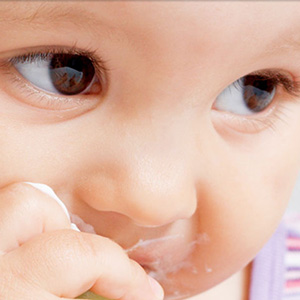Everyone has their own opinion about when can babies drink cows milk. In this blog, you’ll get answers to all your questions about introducing your baby to cow’s milk.
“No cow’s milk before one”, advises your mother.
“Introduce cow’s milk ASAP. They’ll get an allergy”, warns your best friend.
“OMG, avoid dairy at all costs”, commands karen1987
Head about to explode? It’s hardly surprising. In this blog, you’ll get answers to all your questions about introducing your baby to cow’s milk.

The best time to offer babies cows milk
You can introduce potentially allergenic foods, including cows’ milk protein, anytime during weaning.
Current guidelines allow for small amounts of cows’ milk in food. BUT, breast milk or formula should be your baby’s main milk drink until their first birthday.
Formula-fed babies: have they already been exposed to cows milk protein?
Yes.
Infant formula is made from cow’s milk and modified for babies. So when your baby drinks infant formula, they drink cow’s milk protein. If your baby tolerates infant formula, you know they will handle the protein in regular milk when you add this to food during weaning.
Breastfed babies: Do the same rules apply to cows’ milk introduction?
Yes and no!
If your baby is exclusively breastfed, they haven’t been directly exposed to cow milk protein. Although small trace amounts of cow’s milk protein can pass into your breast milk, these are minimal.
Follow these THREE RULES for introducing a potential allergen like cows milk.
- Introduce each new food one at a time, e.g. don’t introduce cows milk and Weetabix on the same day.
- Start low (e.g., 1/4-1/2 tsp milk in food) and increase slowly over the next few days.
- Once successfully introduced, continue to give the food (in this case, milk) to your baby regularly as part of their usual diet.
Why is it OK to use cow’s milk in solid foods but not drink cow’s milk?
You can use cows’ milk when you cook or prepare foods like porridge from around six months. But don’t give it as a drink to your baby until after their first birthday.
Why?
Young babies can’t digest milk (cows milk) in large quantities, and too much can cause blood loss in the gut. This, combined with the fact that cow’s milk is low in iron, can result in iron deficiency which can lead to iron deficiency anaemia.
When can babies drink cows’ milk?
Babies can drink cow’s milk as their main milk drink after 12 months of age.
Why drink milk at all? The nutritional value of cow’s milk
Milk is a well-known source of calcium, but it’s also a handy package of other vital nutrients, including protein, vitamin B12 and iodine. Some milk (mega, super or fortified) is fortified with vitamin D.
A glass of cows milk (100mls) contains:
Energy 267kJ/64kcal
Fat 3.5g
Carbohydrate 4.7g (this is natural milk sugar called ‘lactose’. Lactose is NOT a ‘free sugar’).
Protein 3.4g
Salt 0.11g
Calcium (mg) 119mg
Vitamin B12 (µg) 0.4µg
What’s the best milk to choose for your baby?
Regular cow’s milk
In Ireland, whole milk typically contains 3.5 per cent fat. It generally offers about 63 calories per 100mls. Whole cow’s milk is recommended for children under two years of age.
Choose whole milk!
Semi-skimmed or reduced fat cow’s milk
Semi-skimmed milk contains no more than 1.8 per cent fat, giving it around half the fat content of whole milk. You’ll often see it as “low fat” for sale in shops. It’s generally about 46 calories per 100mls.
Children over two years can use low-fat or semi-skimmed milk.
Skimmed
Although it’s sometimes marketed as “fat-free”, skimmed milk contains around 0.5 per cent fat. Despite being virtually fat-free, it’s not lower in calcium than whole milk.
However, due to its low-calorie content, this lower-fat milk (34 calories per 100mls) is not recommended for children under five years.
Fortified
Fortified milk, which can be either whole or reduced fat milk contains added vitamins and minerals. These typically include vitamin D, also known as the sunshine vitamin and folic acid, which is especially important for women who may become pregnant.
Protein milk
Although cow’s milk is naturally rich in protein, some milk producers add extra whey and casein protein and market this as ‘protein milk’.
We generally don’t recommend this for babies. As they get enough protein from their regular diet, and we don’t need them to get too much protein.

Is it best to use breast milk or cow’s milk to make up porridge?
This is totally up to you.
Some breastfeeding mums express breast milk to use in food. Others have a freezer stash of breast milk to use up. For others, expressing is a hassle they can live without! So, either use expressed breast milk or whole cow’s milk when making up porridge. I don’t recommend making it with water as it dilutes the meal’s nutritional content.
Remember that when you heat breast milk to make porridge, you destroy some of the live components of the breast milk.
Is it best to use infant formula or whole cow’s milk to make up food?
Again, there’s no right or wrong. If you have the formula to hand, adding this to food is an option. Before adding to food, makeup the formula fresh – don’t use leftover milk from a previous feed.
What about organic milk for babies? Is it worth the cost?
Organic milk comes from cows raised on farms using organic farming methods. The nutritional differences between organic and regular milk are minor.
Organic varieties usually contain higher omega-3 fatty acids, although the absolute amount is still relatively low. Milk isn’t generally considered a reliable source of omega-3 fats.
Organic products also contain about a third less iodine compared to regular milk. Iodine is an essential nutrient for your baby’s brain development.
So, no, it’s not necessary to buy organic milk.
Is raw milk beneficial for babies?
You may see ‘wellness gurus’ recommending unpasteurised milk for various reasons. If you’re from a farm, you may even have drunk it as a child. However, it is NOT safe, especially for babies.
Children are more vulnerable than adults to the pathogens that can occur in unpasteurised milk.
Pasteurisation is a simple process that involves heating milk to a specified temperature and time to destroy harmful microorganisms. The temperature and duration of heating are relatively low, so it’s sufficient to destroy harmful microorganisms without significantly destroying the good stuff! Studies show that pasteurisation has minimal impact on milk’s nutritional quality. The only vitamin reduced by heating is vitamin C, but cow’s milk is a poor source of vitamin C anyway!
Generally, milk for sale in Ireland is pasteurised, and the Food Safety Authority of Ireland advises against consuming or selling raw (unpasteurised) milk.
Plant-based milk: What is it, and what’s suitable for babies?
You may want to choose plant-based milk because your family is vegan or because your child has a cow’s milk allergy.
But, so many milk alternatives are available that it can get confusing. Options for cows milk alternatives include soya or soy milk, oat milk, pea milk, coconut and almond milk.
It’s important to understand that plant-based milk alternatives don’t provide the same amount of energy and some other nutrients as animal milk. You must take care to meet all nutrient needs if children eat a vegan diet.

Three tips for choosing the best plant-based milk for babies
- Aim for plant milk with energy as close to 60kcals /100mls as possible, as this is what breastmilk is. Make sure it’s at least 45kcals/100mls. And make sure you’re supplementing the diet with even more fat to make sure that you’re bridging the gap.
- Make sure it’s fortified with calcium, B12, vitamin D and Iodine. Some are fortified with additional vitamins and minerals too.
- Warning, a lot of organic milk ISN’T fortified. And if they are, they tend only to contain calcium.
*Some plant-based milk contains added sugars. Generally, they are still relatively low in sugar. We tend to way up the quality of the overall product rather than avoid all those with added sugars.
Care needs to be taken if introducing plant-based milk alternatives as the main milk drinks for very young children.
Remember, it is OK to use these as options in cooking and preparing food. Plant-based milk is NOT suitable as the main milk drink for babies under 12 months.
Soya milk substitute
A calcium-fortified soya-based milk alternative is the most cost-effective and easy-to-buy plant-based milk alternative. It’s lower in energy (fat) than full-fat milk so make sure that you’re offering other sources of fat in your child’s diet if this is the main milk provided.
Even more plant-based milk alternatives
- Unsweetened fortified pea-based milk alternative has a similar energy and protein content to soya milk but may not be fortified with riboflavin.
- Oat-based milk alternatives will contain free sugars from the processing of the oats used.
- Nut-, coconut- and hemp-based milk alternatives can be low in energy and protein and may not have the same level of fortification.
- Rice milk isn’t recommended for children under five due to trace amounts of arsenic.
Care needs to be taken when using these plant-based milk alternatives as the main milk drink for very young children, and it’s best to discuss your milk choice and your child’s diet with a health professional.
What cow’s milk alternatives are best for babies with a milk allergy?
Breast milk or formula (extensively hydrolysed or amino acid) are the only suitable milk drinks for babies under one year. However, alternative milk, such as fortified soya or oat milk, can be used to make up solid foods.
After your baby’s first birthday, you can continue offering breast milk or formula. Or talk to your dietitian about whether it’s suitable to move from a specialist formula to off-shelf non-dairy milk such as soy milk. Whether to move on depends on your baby’s healthy growth and the amount of healthy fats in your baby’s diet.
If your baby has a milk allergy, you should always get one-to-one advice from a registered dietitian and medical advice before reintroducing cow’s milk at home.
Drinking milk and lactose intolerance-what are your options?
The natural sugars in cow’s milk and breast milk are called lactose. An enzyme called lactase in the gut breaks this complicated sugar into smaller sugars so the body can absorb and use it.
As young children grow up and drink less milk, the amount of this enzyme gradually and naturally falls. For some children, especially those from an Asian or African ethnic background, this may mean that over time, not all the lactose they consume is broken down. Very gradually, gut symptoms of lactose intolerance begin to develop.
These symptoms may include bloating, tummy pains, wind and very loose stools – it does not include constipation or reflux/vomiting. However, this does not usually happen until later in childhood and rarely occurs in young babies. (IMAP Guidelines, 2016).
Although lactose-free alternative milks are available in the supermarket, you should always get advice from a registered dietitian before using these with your baby or young child.
Cows milk versus toddler formula and toddler drinks
Toddler and growing-up milk contain more sugar than cow’s milk and may have the wrong balance of nutrients. Experts across Europe have agreed that young children don’t need these toddler growing up milk to obtain particular nutrients.
Offering sweetened beverages to young children may also contribute to developing a sweet tooth and being overweight in childhood. (First Steps Nutrition)
How much milk is needed after 12 months of age?
Cow’s milk, and other dairy foods like cheese and yoghurt are in the same food group.
Ages 1 to 4: 3 servings a day from this group (HSE)
One serving is:
- 200ml plain milk (this includes breast milk)
- One pot (125g) of plain yogurt
- 2 small pots (47g) plain or natural fromage frais
- Two adult thumbs of cheese
- Homemade custard or rice pudding made with 200ml of milk
- 2 x 100ml unsweetened soya milk fortified with calcium
Offering milk as a drink with meals is an easy way to get 1 of the three daily servings.
One serving can combine two foods or drinks. For example, one serving could be 100ml of milk with one small pot (47g) of plain or natural fromage frais. Or 100ml milk with one adult thumb of cheese.
Breastmilk counts towards these servings. The World Health Organization recommend continuing to provide breastmilk up to 2 years of age or beyond
If breastfeeding, you can still add cow’s milk to your child’s cereal or offer cow’s milk as a drink.
Other calcium-rich foods
Milk and other foods in the dairy group aren’t the only sources of calcium in our diets. Other calcium-rich foods include certain green vegetables like broccoli and kale, calcium-set tofu, calcium-fortified bread and cereals (like Ready Brek) and tinned fish where you eat the bones.
Can my toddler get enough calcium without drinking cow’s milk?
Yes. Not every toddler likes to drink milk. That’s OK! As you can see, there are many other ways of meeting your toddler’s requirements from this food group. Check out this example for reassurance:
- Breakfast: Ready Brek (this is fortified with calcium) made with milk
- Snack: Yoghurt and sliced apple
- Lunch: Beans on toast (use fortified bread for extra calcium)
- Snack: Fruit smoothie made with strawberries and milk
- Dinner: Spaghetti bolognese with grated cheese and broccoli (broccoli is high in calcium)
This toddler meets their requirements of calcium, protein and iodine without difficulty.
Is there an issue with TOO much milk after 12 months of age?
Young children frequently drink more milk than is recommended or needed.
Hands up, who’s toddler would prefer to lounge on the couch with a beaker of milk watching Peppa Pig than sit up at the table for dinner?
Giving cow’s milk outside of meal and snack time interferes with your toddler’s appetite. Instead, it’s better to let your toddler drink milk as part of a meal or snack at the table.
Ideally, You should offer cow’s milk from a little open cup, straw cup or free-flowing beaker rather than from a sippy cup or bottle. You can provide milk before bed if this fits in with your toddlers’ bedtime routine.
Too much cow’s milk can also cause iron deficiency anaemia in young children.
Who would have thought there was SO MUCH to say about milk?!
So, the next time your mother, friend or random online stranger shares their opinion about cows’ milk, I hope you’re well prepared with the correct information!







0 Comments